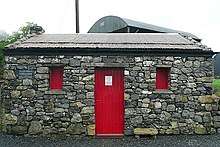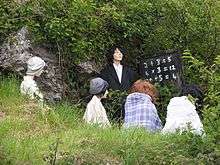Hedge school
Hedge schools (Irish names include scoil chois claí, scoil ghairid and scoil scairte) were small informal illegal schools, particularly in 18th- and 19th-century Ireland, designed to secretly provide the rudiments of primary education to children of 'non-conforming' faiths (Catholic and Presbyterian). Under the penal laws only schools for those of the Anglican faith were allowed. Instead Catholics and Presbyterians set up highly informal secret operations that met in private homes.[1]


History
Historians generally agree that they provided a kind of schooling, occasionally at a high level, for up to 400,000 students by the mid-1820s. J. R. R. Adams says the hedge schools testified “to the strong desire of ordinary Irish people to see their children receive some sort of education.” Antonia McManus argues that there “can be little doubt that Irish parents set a high value on a hedge school education and made enormous sacrifices to secure it for their children....[the hedge schoolteacher was] one of their own”.[2]
While the "hedge school" label suggests the classes took place outdoors (next to a hedgerow), classes were normally held in a house or barn. Subjects included primarily the reading, writing and grammar of the Irish and English languages, and maths (the fundamental "three Rs"). In some schools the Irish bardic tradition, Latin, history and home economics were also taught. Reading was often based on chapbooks, sold at fairs, typically with exciting stories of well-known adventurers and outlaws. Payment was generally made per subject, and bright pupils would often compete locally with their teachers.
While all Catholic schools were forbidden under the Penal laws from 1723 to 1782, no hedge teachers were known to be prosecuted. Indeed, official records were made of hedge schools by census makers, such as that in Clare.[3] The Penal Laws targeted education by the Catholic religious orders, whose wealthier establishments were sometimes confiscated. The laws aimed to force Irish Catholics of the middle classes and gentry to convert to Anglicanism if they wanted a good education in Ireland.
Formal schools for Catholics under trained teachers began to appear after 1800. Edmund Ignatius Rice (1762–1844) founded two religious institutes of religious brothers: the Congregation of Christian Brothers and the Presentation Brothers. They opened numerous schools, which were visible, legal, and standardized. Discipline was notably strict.[4]
Hedge schools declined from the foundation of the National School system by the British government in the 1830s. Most of the Catholic bishops preferred this, as the new schools would be largely under the control of the Catholic Church and allow better control of the teaching of Catholic doctrine. James Doyle, Bishop of Kildare and Leighlin wrote to his priests in 1831:
The Roman Catholic bishops welcome the rule which requires that all the teachers are henceforth to be employed be provided from some Model School, with a certificate of their competency, that will aid us in a work of great difficulty, to wit, that of suppressing hedge schools, and placing youths under the direction of competent teachers, and of those only.
A study of hedge schools by Yolanda Fernández-Suárez of the University of Burgos[5] found that hedge schools existed into the 1890s, and suggested that the schools existed as much from rural poverty and a lack of resources as from religious oppression. Marianne Eliott also mentions that they were used by the poor and not just by the Catholics.
After 1900, historians such as Daniel Corkery tended to emphasize the hedge schools' classical studies (in Latin and Greek), but while these studies were sometimes taught (based on a local demand), they were not taught in every school.
Fernández-Suárez quotes a Board of Education inspector visiting a school in 1835:
Amazed at the skill of the twelve-year-old boys in reading the new books, and considering the possibility that they were reciting from memory, I invited one of their number to read me a passage from the gospel of Saint Matthew. Evidently the child misunderstood me. He searched in his satchel until he found his tattered book, stood up, and proceeded to read me the account of Christ’s passion—in Greek (Local Ireland & Others 1999).[6]
In popular culture
- Brian Friel's play Translations is set in a hedge school, and its subject is the defence of Irish culture against a dominant and aggressive colonisation.
- William Makepeace Thackeray's Irish Sketch Books contain various references to hedge schools.
- William Carleton, who got his own early education in hedge schools, wrote many comedic accounts of them for the English audience, including The Hedge School.[7]
References
- Lyons, Tony (October 26, 2016). "'Inciting the lawless and profligate adventure'—the hedge schools of Ireland". History Ireland.
- Historians Adams and McManus are quoted in Michael C. Coleman, American Indians, the Irish, and Government Schooling: A Comparative Study (2005) p 35.
- See list
- Dáire Keogh, "Forged in the Fire of Persecution: Edmund Rice (1762–1844) and the Counter-Reformationary Character of the Irish Christian Brothers." in Brendan Walsh, ed., Essays in the History of Irish Education (2016) pp. 83–103.
- http://www.estudiosirlandeses.org/2006/03/an-essential-picture-in-a-sketch-book-of-ireland-the-last-hedge-schools/
- In Fernández-Suárez' study quoted as 'From the papers of the Archdeacon of Fern' (correctly Ferns).
- http://www.irishhistorylinks.net/Historical_Documents/Carleton_Hedge_School.html
Further reading
- Adams, J.R.R. "The Hedge Schools and popular education in Ireland". Chapter 5 in Irish Popular Culture 1650–1850 edited by J Donnelly & K Miller, Irish Academic Press 1999, ISBN 0-7165-2712-X
- Marianne Elliott, The Catholics of Ulster, Penguin 2001, at pp. 179–181.
- Fernández-Suárez, Yolanda. "An Essential Picture in a Sketch-Book of Ireland: The Last Hedge Schools", Estudios Irlandeses
- Lyons, Tony. "The Hedge Schools Of Ireland." History 24#6 (2016). pp 28–31 online
- McManus, Antonia. The Irish Hedge School and Its Books, 1695–1831 (2002)